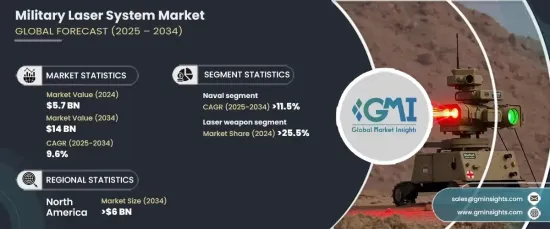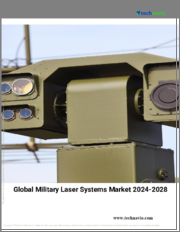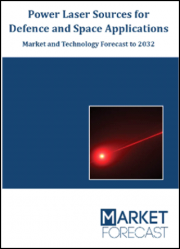
|
시장보고서
상품코드
1667102
군용 레이저 시스템 시장 기회, 성장 촉진 요인, 산업 동향 분석, 예측(2025-2034년)Military Laser System Market Opportunity, Growth Drivers, Industry Trend Analysis, and Forecast 2025 - 2034 |
||||||
군용 레이저 시스템 세계 시장은 2024년 57억 달러로 평가되었고, 2034년까지 연평균 복합 성장률(CAGR) 9.6%로 성장할 것으로 예측됩니다.
이 시장의 확대는 드론, 미사일 및 기타 최신 무기와 같은 새로운 위협에 대처하기 위한 첨단 솔루션을 추구하는 세계 군의 정밀 유도 기술에 대한 수요 증가가 원동력이 되고 있습니다. 레이저 시스템은 정확성, 비용 효과 및 다양한 환경 조건 하에서 움직이는 물체를 표적화하는 능력으로 지원됩니다. 또한, 고에너지 레이저와 지향성 에너지 무기의 발전은 기존의 방어 전략을 변화시키고 시장 성장에 중요한 역할을 합니다.

인공지능(AI)은 군용 레이저 시스템에 점점 통합되어 자율적으로 작동하는 능력을 향상시키고 있습니다. AI를 통해 레이저는 자동으로 위협을 식별하고, 목표를 정하고, 실시간으로 상황을 분석하고, 에너지 소비를 최적화할 수 있습니다. 제조업체는 또한 이러한 시스템의 소형화에 주력하고 있으며, 이식성을 향상시킬 뿐만 아니라 운영 비용을 절감하고 합리적인 가격으로 만들고 있습니다. 레이저와 레이더와 센서를 결합한 하이브리드 시스템도 성장 동향의 하나이며, 어려운 환경에서의 상황 인식과 의사 결정을 강화하고 있습니다. 군가 극초음속 미사일, 무인 항공기, 사이버 공격 등의 진화하는 위협에 대항하기 위해 비-키네틱 솔루션을 요구하고 있기 때문에 레이저 시스템 수요는 계속 증가하고 있습니다.
| 시장 범위 | |
|---|---|
| 시작연도 | 2024년 |
| 예측연도 | 2025년-2034년 |
| 시작금액 | 57억 달러 |
| 예측 금액 | 140억 달러 |
| CAGR | 9.6% |
군용 레이저 시스템 시장은 제품 유형별로 구분되며, 레이저 무기, 레이저 디지게이터, 라이더, 레이저 레인지 파인더, 링 레이저 자이로스코프, 레이저 고도계 등이 중요한 역할을 하고 있습니다. 그 중에서도 레이저 무기는 시장의 상당한 점유율을 차지하며 큰 성장이 예상됩니다. 이 무기는 드론, 전투기, 함정, 지상 차량 등 다양한 방어 플랫폼에 탑재되어 왔습니다. 높은 정밀도와 낮은 운용 비용으로 표적을 배제하는 능력으로 현대의 군사 작전에서는 귀중한 존재가 되고 있습니다.
이 시장은 또한 육상, 공수, 해군, 우주 등 여러 주요 최종 용도 분야에 걸쳐 있습니다. 해군 부문은 고에너지 레이저가 해군 방어 시스템의 필수 구성 요소가 됨에 따라 상당한 성장이 기대됩니다. 이 레이저는 전통적인 군수품에 비해 빠른 응답 시간, 높은 정밀도, 낮은 비용을 제공합니다. 레이저 시스템과 레이더와 적외선 센서의 조합은 다양한 해양 환경에서 위협을 감지하고 추적하는 함정의 능력을 더욱 강화합니다.
북미, 특히 미국은 군용 레이저 시스템 시장을 독점하고 있으며, 2034년까지 60억 달러 이상에 달할 것으로 예상됩니다. 미군의 지향성 에너지 무기에 대한 지속적인 투자와 대 드론 기술에 대한 주력 증가가 이 시장의 확대를 촉진하는 주요 요인입니다. 방위기관이 방어능력 혁신과 업그레이드를 계속하고 있기 때문에 첨단 레이저 시스템 수요는 다양한 군사 분야에서 꾸준히 증가할 것으로 보입니다.
목차
제1장 조사 방법과 조사 범위
- 시장 범위와 정의
- 기본 추정과 계산
- 예측 계산
- 데이터 소스
- 1차
- 2차
- 유료소스
- 공적소스
제2장 주요 요약
제3장 업계 인사이트
- 업계 생태계 분석
- 밸류체인에 영향을 주는 요인
- 이익률 분석
- 변혁
- 장래의 전망
- 제조업체
- 유통업체
- 공급자 상황
- 이익률 분석
- 주요 뉴스
- 규제 상황
- 영향요인
- 성장 촉진요인
- 정밀 무기에 대한 수요 증가
- 고에너지 레이저와 지향성 에너지 무기의 기술 진보
- 무인항공기(UAV), 무리 무인 항공기, 극초음속 미사일 등 비기존적인 위협 증가
- 인공지능(AI)과 자율 시스템을 레이저 기술에 통합
- 레이저 시스템의 소형화와 휴대형 플랫폼의 개발
- 업계의 잠재적 리스크 및 과제
- 높은 개발 및 운용 비용
- 규제와 법적 우려
- 성장 촉진요인
- 성장 가능성 분석
- Porter's Five Forces 분석
- PESTEL 분석
제4장 경쟁 구도
- 소개
- 기업의 시장 점유율 분석
- 경쟁 포지셔닝 매트릭스
- 전략 전망 매트릭스
제5장 시장 추정 및 예측 : 출력별, 2021년-2034년
- 주요 동향
- 10 kW 이하
- 10 kW-100 kW
- 100 kW 이상
제6장 시장 추정 및 예측 : 제품별, 2021년-2034년
- 주요 동향
- 레이저 감지기
- 라이더
- 3D 스캐닝
- 레이저 무기
- 레이저 거리계
- 링 레이저 자이로스코프
- 레이저 고도계
제7장 시장 추정 및 예측 : 기술별, 2021년-2034년
- 주요 동향
- 고체 레이저
- 광섬유 레이저
- 반도체 레이저
- 가스 레이저
- 액체 레이저
- 자유 전자 레이저
제8장 시장 추정 및 예측 : 기능별, 2021년-2034년
- 주요 동향
- 대상 지정 및 범위
- 네비게이션, 유도, 제어
- 방위 대책
- 통신 시스템
- 지향성 에너지 무기
제9장 시장 추정 및 예측 : 최종 사용 용도별, 2021년-2034년
- 주요 동향
- 육상
- 장갑차
- 하차병 시스템
- 포병 시스템
- 공수
- 공격 헬리콥터
- 전투기
- 전술 UAV
- 해군
- 전투함정
- 잠수함
- 무인 지상 차량
- 우주
- 위성
- 우주 기반의 요격 미사일
- 지구에서 우주로의 무기
제10장 시장 추정 및 예측 : 지역별, 2021년-2034년
- 주요 동향
- 북미
- 미국
- 캐나다
- 유럽
- 영국
- 독일
- 프랑스
- 이탈리아
- 스페인
- 러시아
- 아시아태평양
- 중국
- 인도
- 일본
- 한국
- 호주
- 라틴아메리카
- 브라질
- 멕시코
- 중동 및 아프리카
- 남아프리카
- 사우디아라비아
- 아랍에미리트(UAE)
제11장 기업 프로파일
- BAE Systems
- Boeing
- Elbit Systems
- L3Harris Technologies
- Leonardo
- Lockheed Martin
- MBDA
- Newport
- Northrop Grumman
- Raytheon Technologies
- Rheinmetall
- Safran
- Textron
- Thales
The Global Military Laser System Market, valued at USD 5.7 billion in 2024, is projected to grow at a CAGR of 9.6% through 2034. The expansion of this market is driven by the rising demand for precision-guided technologies among military forces worldwide, as they seek advanced solutions to address emerging threats such as drones, missiles, and other modern weaponry. Laser systems are favored for their precision, cost-effectiveness, and ability to target moving objects under various environmental conditions. Furthermore, advancements in high-energy lasers and directed energy weapons are transforming traditional defense strategies, playing a significant role in the market's growth.

Artificial intelligence (AI) is increasingly integrated into military laser systems, enhancing their capability to operate autonomously. With AI, lasers can automatically identify and target threats, analyze situations in real-time, and optimize energy consumption. Manufacturers are also focusing on miniaturizing these systems, which not only improves their portability but also reduces operational costs, making them more affordable. Hybrid systems, which combine lasers with radar and sensors, are another growing trend, enhancing situational awareness and decision-making in high-stakes environments. The demand for laser systems continues to rise as armed forces seek non-kinetic solutions to counter evolving threats, including hypersonic missiles, drone swarms, and cyber-attacks.
| Market Scope | |
|---|---|
| Start Year | 2024 |
| Forecast Year | 2025-2034 |
| Start Value | $5.7 billion |
| Forecast Value | $14 billion |
| CAGR | 9.6% |
The military laser system market is segmented by product type, with laser weapons, laser designators, lidar, laser rangefinders, ring laser gyroscopes, and laser altimeters all playing vital roles. Among these, laser weapons are expected to see significant growth, accounting for a considerable share of the market. These weapons are increasingly integrated into various defense platforms, such as drones, fighter jets, naval ships, and ground vehicles. Their ability to eliminate targets with high precision and low operational costs makes them invaluable in modern military operations.
The market also spans several key end-use sectors, including land, airborne, naval, and space applications. The naval segment is expected to experience substantial growth as high-energy lasers become integral components of naval defense systems. These lasers offer faster response times, greater accuracy, and lower costs compared to traditional munitions. The combination of laser systems with radar and infrared sensors further strengthens naval vessels' ability to detect and track threats in diverse marine environments.
North America, particularly the United States, dominates the military laser system market and is projected to surpass USD 6 billion by 2034. The U.S. military's continued investments in directed energy weapons and its growing focus on counter-drone technology are key factors driving this market's expansion. As defense agencies continue to innovate and upgrade their defense capabilities, demand for advanced laser systems is expected to rise steadily across various military sectors.
Table of Contents
Chapter 1 Methodology & Scope
- 1.1 Market scope & definitions
- 1.2 Base estimates & calculations
- 1.3 Forecast calculations
- 1.4 Data sources
- 1.4.1 Primary
- 1.4.2 Secondary
- 1.4.2.1 Paid sources
- 1.4.2.2 Public sources
Chapter 2 Executive Summary
- 2.1 Industry synopsis, 2021-2034
Chapter 3 Industry Insights
- 3.1 Industry ecosystem analysis
- 3.1.1 Factor affecting the value chain
- 3.1.2 Profit margin analysis
- 3.1.3 Disruptions
- 3.1.4 Future outlook
- 3.1.5 Manufacturers
- 3.1.6 Distributors
- 3.2 Supplier landscape
- 3.3 Profit margin analysis
- 3.4 Key news & initiatives
- 3.5 Regulatory landscape
- 3.6 Impact forces
- 3.6.1 Growth drivers
- 3.6.1.1 Increasing demand for precision weapons
- 3.6.1.2 Technological advancements in high-energy lasers and directed energy weapons
- 3.6.1.3 Rise in unconventional threats such as unmanned aerial vehicles (UAVs), swarming drones, and hypersonic missiles
- 3.6.1.4 Integration of artificial intelligence (AI) and autonomous systems into laser technology
- 3.6.1.5 Miniaturization of laser systems and the development of more portable platforms
- 3.6.2 Industry pitfalls & challenges
- 3.6.2.1 High development and operational costs
- 3.6.2.2 Regulatory and legal concerns
- 3.6.1 Growth drivers
- 3.7 Growth potential analysis
- 3.8 Porter’s analysis
- 3.9 PESTEL analysis
Chapter 4 Competitive Landscape, 2024
- 4.1 Introduction
- 4.2 Company market share analysis
- 4.3 Competitive positioning matrix
- 4.4 Strategic outlook matrix
Chapter 5 Market Estimates & Forecast, By Output Power, 2021-2034 (USD Million & Units)
- 5.1 Key trends
- 5.2 <10 kW
- 5.3 10 kW TO 100 kW
- 5.4 >100 kW
Chapter 6 Market Estimates & Forecast, By Product, 2021-2034 (USD Million & Units)
- 6.1 Key trends
- 6.2 Laser designator
- 6.3 Lidar
- 6.4 3D scanning
- 6.5 Laser weapon
- 6.6 Laser range finder
- 6.7 Ring laser gyroscope
- 6.8 Laser altimeter
Chapter 7 Market Estimates & Forecast, By Technology, 2021-2034 (USD Million & Units)
- 7.1 Key trends
- 7.2 Solid-state laser
- 7.3 Fiber laser
- 7.4 Semiconductor laser
- 7.5 Gas laser
- 7.6 Liquid laser
- 7.7 Free-electron laser
Chapter 8 Market Estimates & Forecast, By Function, 2021-2034 (USD Million & Units)
- 8.1 Key trends
- 8.2 Target designation and ranging
- 8.3 Navigation, guidance, & control
- 8.4 Defensive countermeasures
- 8.5 Communication system
- 8.6 Directed energy weapons
Chapter 9 Market Estimates & Forecast, By End Use Application, 2021-2034 (USD Million & Units)
- 9.1 Key trends
- 9.2 Land
- 9.2.1 Armored vehicles
- 9.2.2 Dismounted solider system
- 9.2.3 Artillery system
- 9.3 Airborne
- 9.3.1 Attack helicopters
- 9.3.2 Fighter aircraft
- 9.3.3 Tactical UAVs
- 9.4 Naval
- 9.4.1 Combat ships
- 9.4.2 Submarines
- 9.4.3 Unmanned surface vehicles
- 9.5 Space
- 9.5.1 Satellite
- 9.5.2 Space-based interceptors
- 9.5.3 Earth to space weapons
Chapter 10 Market Estimates & Forecast, By Region, 2021-2034 (USD Million & Units)
- 10.1 Key trends
- 10.2 North America
- 10.2.1 U.S.
- 10.2.2 Canada
- 10.3 Europe
- 10.3.1 UK
- 10.3.2 Germany
- 10.3.3 France
- 10.3.4 Italy
- 10.3.5 Spain
- 10.3.6 Russia
- 10.4 Asia Pacific
- 10.4.1 China
- 10.4.2 India
- 10.4.3 Japan
- 10.4.4 South Korea
- 10.4.5 Australia
- 10.5 Latin America
- 10.5.1 Brazil
- 10.5.2 Mexico
- 10.6 MEA
- 10.6.1 South Africa
- 10.6.2 Saudi Arabia
- 10.6.3 UAE
Chapter 11 Company Profiles
- 11.1 BAE Systems
- 11.2 Boeing
- 11.3 Elbit Systems
- 11.4 L3Harris Technologies
- 11.5 Leonardo
- 11.6 Lockheed Martin
- 11.7 MBDA
- 11.8 Newport
- 11.9 Northrop Grumman
- 11.10 Raytheon Technologies
- 11.11 Rheinmetall
- 11.12 Safran
- 11.13 Textron
- 11.14 Thales



















